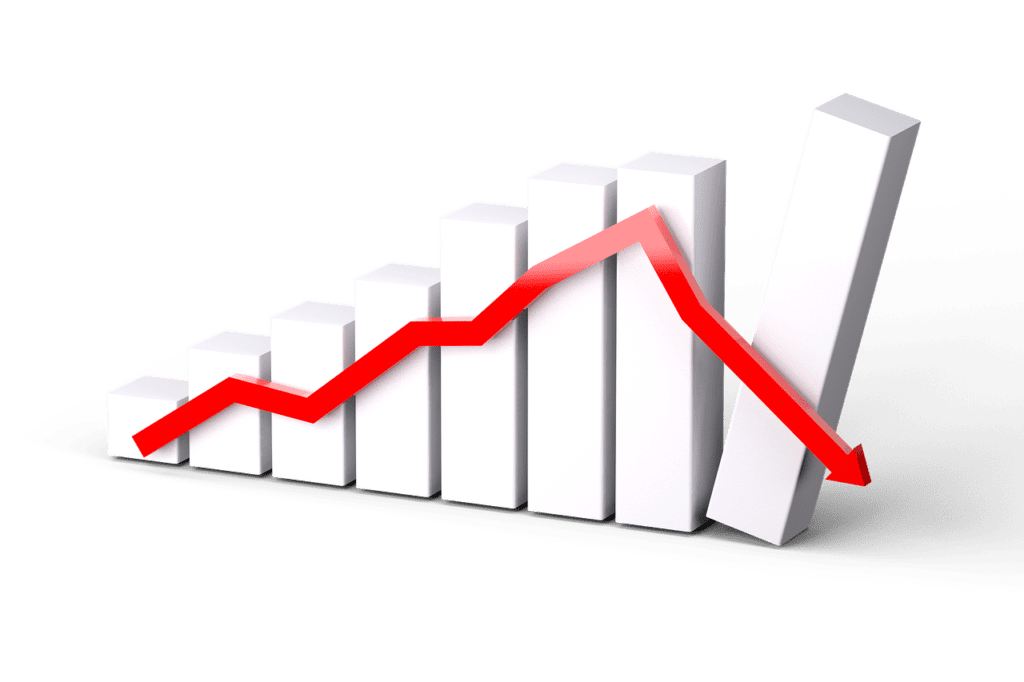After a long spring and much speculation about the future of the European economy, it looks like the recession is now here. It has not engulfed all of Europe yet, but second-quarter, Q2, data on GDP tell a pessimistic story about where the continent is heading.
Although Eurostat has not yet released data for all the EU member states—a handful of countries have yet to report their Q2 numbers—the statistics agency provides a preliminary estimate for the euro zone, for 19 of the 27 EU member states, and for the union as a whole:
- The economy of the entire EU grew by an estimated 0.5% in the second quarter, down from almost 1.1% in the first quarter;
- The euro zone with its 20 members grew by an estimated 0.6% in Q2, down from just over 1.1% in Q1.
These are technically not recession numbers, but they are low enough to suggest negative numbers in the third quarter. More importantly, they add to a troubling trend of economic weakening; this was the third quarter in a row with growth rates below two percent.
For comparison, in the second quarter of 2022, the European economy was still growing at more than 4% per year.
The bad outlook for Europe is manifested primarily in the number of countries reporting negative growth: so far, eight EU member states have reported an inflation-adjusted decline in GDP for Q2. Estonia leads the plunge with -3%, followed by Sweden (-2.2%), and Poland (-1.3%). Of the countries that still have an expanding economy, only Romania (2.7%) and Cyprus (2.3%) have reliably good numbers. Ireland clocks a 2.8% year-to-year growth rate in the second quarter, but their economy is notoriously volatile and excessively dependent on exports. This makes any single quarter number an unreliable piece of information on the overall performance of their economy.
Notably, Germany has now fallen into negative territory, with its GDP at -0.1% compared to the second quarter last year. They have now recorded two quarters in a row with negative year-to-year growth, which is a classic definition of a recession. Three other EU member states are in the same situation: Czechia, Estonia, and Poland.
Other economies add to the pessimistic outlook by exhibiting trends that precipitate negative GDP numbers in the near future. France saw a 0.9% year-to-year growth rate for the second quarter, now having three quarters in a row below 1%. For all practical intents and purposes, this is economic stagnation; the mighty French economy is moving only marginally faster than a Renault 4 that has run out of gasoline.
Sweden is in even more trouble than France. In the third quarter of 2022, the Swedish economy grew by 2.6%. It swung around to -0.3% in the fourth quarter. A tepid positive number of 0.5% for the first quarter this year was followed by -2.2% for the second quarter. This downward ratchet is substantial and puts Sweden at the forefront of recession alarm bells. Let us keep in mind that the Swedish inflation rate stubbornly remains above 6% and that their central bank, the Riksbank, appears determined to keep its interest rates high for the foreseeable future.
When the Renault is standing still, the Volvo is rolling backwards.
The Spanish economy has been doing relatively well recently, with growth rates of 3-5% per year in the last half of 2022 and the first quarter of this year. However, in the second quarter their economy expanded at less than 1.8%. They are in good company: the Italian GDP grew at 0.5% in Q2, down from 2% in Q1.
As mentioned, eight countries have not yet reported their second-quarter GDP numbers to Eurostat. When they do, we will likely have more countries with a shrinking economy. I expect Hungary to be in this category: with -1.1% in Q1, they were one of seven EU states that began 2023 with a declining economy. Their Q2 number will probably be somewhere near the Polish -1.26%, but I would not expect Hungary to go into any deeper recession. Their inflation rate is coming down, and their government finances are configured in a way that makes them more resilient in recessions. This has significantly reduced the risk for budget problems that otherwise tend to destabilize government finances in recessions.
Last but not least, the Hungarians can respond to a recession in ways that most EU member states cannot do. Hungary is one of seven EU members that have wisely chosen not to join the euro zone.
All in all, the GDP data available thus far for the second quarter spells recession, but in order to assess the strength of the downturn we need to include unemployment numbers. Unfortunately, Eurostat has not yet published unemployment statistics for July, so we cannot get an early hint of what the third quarter will look like. However, a comparison of March and June, the respective end months of the first and second quarters, shows that only six EU member states had a higher unemployment rate in June. In the rest of the union, unemployment continued to fall through the second quarter.
This overall picture is encouraging: the weakening economy has not yet begun robbing working Europeans of their incomes.
There are exceptions, of course, with three countries experiencing a mild increase in unemployment:
- In Czechia, it was up from 2.6% in March to 2.7% in June;
- In Germany, it rose from 2.9% to 3.1%;
- In Finland, it increased from 6.9% to 7.2%.
Then there are the bad ones:
- Estonia: from 5.9% to 6.7%;
- Ireland: from 4.1% to 4.6%; and
- Sweden: from 7.7% to 9.2%.
The trend in Estonia is not surprising given that they have experienced five quarters in a row with a shrinking economy. The sharpest drop in their GDP, -3.9%, took place in the last quarter of 2022, but unemployment has continued to rise. It will keep doing so until the economy stops shrinking, probably before the end of this year; do not be surprised if their unemployment rate peaks at 8%.
The rise in unemployment in Ireland happens while their economy is growing by 2.8% year over year. This is absurd from a macroeconomic viewpoint, but the Irish economy is in some ways absurd. It has unusual characteristics that set it apart from other European economies. I will write a special review of the green island’s economic idiosyncrasies in the coming weeks.
Sweden is the most serious case of the ones with rising unemployment. The jump from 7.7% to 9.2% puts Sweden in third place in the EU for the month of June. In March, Sweden shared fourth place with Lithuania. Furthermore, the distance between Sweden and the country with the highest unemployment—that would be Spain in both March and June—has shrunk noticeably: in March, Spanish unemployment was 13%, putting the Spanish rate 5.3 percentage points above Sweden; in June, the Spanish rate was only two percentage points higher.
Since Spanish unemployment is still shrinking and their economy is still growing—almost 1.8% in Q2—by the end of the third quarter, Sweden will probably have a higher unemployment rate than Spain.
Greece, which in June had the second highest unemployment at 10.3%, has also seen a cantered decline in the last several quarters. Eurostat has yet to report the GDP figure for Greece for Q2, but given that their unemployment has not yet started increasing, it is likely to be a modest positive number. This means that Sweden could also exceed Greece and end the third quarter with the highest unemployment rate in the EU.
It is a bit disappointing that Eurostat is so lethargic in publishing labor-market figures. Data on hours worked, jobs gained or lost, unemployment rising or falling, is highly useful in the analysis of macroeconomic trends. In lieu of such data, we turn to interest rates, which have some influence on key economic decisions, especially by households.
Figure 1 reports the rates on the 1-year, the 10-year, and the 30-year treasury securities denominated in euros (for all credit ratings) thus far in 2023. All three are rising, but the 1-year is rising past the other two; at long last, Europe is unfortunately adopting America’s inverted yield curve. The reason for this is a matter for another article; for Europe’s households and businesses it eventually means higher interest rates on revolving bank loans, i.e., credit cards.
Figure 1
Source: European Central Bank via Eurostat
It is not just short-term revolving credit that will become more expensive. With rising long-term rates on government securities, mortgages, car loans, and business investment financing also become more expensive. This cools off consumer purchases of durable goods and discourages businesses from expanding their activities.
The latter effect is less pronounced than the former, in good part because many corporations have the ability to partially or entirely fund investments through off-market channels (in-house funding, special bank deals, bond issuance). Nevertheless, the rise in interest rates will have a negative effect on the expansion plans of smaller businesses, and that is not good since they tend to be the strongest job creators.
If interest rates continue to rise like they have thus far in 2023, their effect on the economy as a whole will be noticeably negative. If inflation remains high, this injects more pricing uncertainty into the economy; interest rates are prices on credit and factor into the price of credit-funded products. The compound effect in terms of rising uncertainty about the future will be the decisive weight on the scale.
With so much pointing to a recession, is there anything Europe’s policymakers can do to prevent it, or at least make it milder?
On the monetary side, there is not much help to be had. The European Central Bank most recently raised its three official interest rates on August 2nd, and the ECB is not likely to reduce them any time soon. At 5.3%, inflation is still too high, especially for a stagnant economy on its way into a recession. Furthermore, so long as the Federal Reserve keeps its rates high and the U.S. economy refuses to go into a recession, the ECB has little room to move.
In addition, if the ECB did cut interest rates, they would depreciate the euro. That, in turn, would add to inflation (as imported goods and services become more expensive) just as the ECB is trying to move inflation in the opposite direction. In other words, it is more likely that the ECB will raise interest rates, not lower them, before the end of the year.
The only option for helping Europe fight the recession would be for member-state legislatures to rely on fiscal policy, i.e., taxes and government spending. The problem here is that government finances are already weak, and rising interest rates raise the marginal cost of new debt. It will be hard for governments across the EU to stimulate their economies in the traditional sense; there are individual exceptions, but with this as the general rule, it is difficult to find a clear path for Europe out of this recession.
However, all hope is not lost. There is one way to mitigate a recession that does not inflict any costs on taxpayers, present or future: deregulation. Europe is a heavily regulated economy, even more so than the American one. A campaign to reduce red tape across the economy, from the labor market to business start-ups to the environment, could tip the economic outlook in a favorable direction.
It is notoriously difficult to estimate the economic benefits of individual regulations, but as a rule of thumb for the American economy, for every $100 we pay in taxes, we lose $50 as a result of onerous and growth-stifling regulations. We have good reasons to believe the parity is similar in Europe. Therefore, a concerted deregulation campaign can have the same effect on the economy as tax cuts, without putting the government’s finances in jeopardy.





